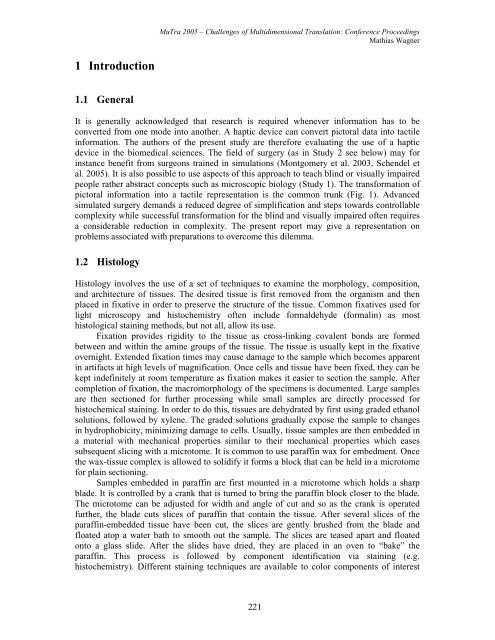Proceedings - Translation Concepts
Proceedings - Translation Concepts
Proceedings - Translation Concepts
Create successful ePaper yourself
Turn your PDF publications into a flip-book with our unique Google optimized e-Paper software.
MuTra 2005 – Challenges of Multidimensional <strong>Translation</strong>: Conference <strong>Proceedings</strong><br />
Mathias Wagner<br />
1 Introduction<br />
1.1 General<br />
It is generally acknowledged that research is required whenever information has to be<br />
converted from one mode into another. A haptic device can convert pictoral data into tactile<br />
information. The authors of the present study are therefore evaluating the use of a haptic<br />
device in the biomedical sciences. The field of surgery (as in Study 2 see below) may for<br />
instance benefit from surgeons trained in simulations (Montgomery et al. 2003, Schendel et<br />
al. 2005). It is also possible to use aspects of this approach to teach blind or visually impaired<br />
people rather abstract concepts such as microscopic biology (Study 1). The transformation of<br />
pictoral information into a tactile representation is the common trunk (Fig. 1). Advanced<br />
simulated surgery demands a reduced degree of simplification and steps towards controllable<br />
complexity while successful transformation for the blind and visually impaired often requires<br />
a considerable reduction in complexity. The present report may give a representation on<br />
problems associated with preparations to overcome this dilemma.<br />
1.2 Histology<br />
Histology involves the use of a set of techniques to examine the morphology, composition,<br />
and architecture of tissues. The desired tissue is first removed from the organism and then<br />
placed in fixative in order to preserve the structure of the tissue. Common fixatives used for<br />
light microscopy and histochemistry often include formaldehyde (formalin) as most<br />
histological staining methods, but not all, allow its use.<br />
Fixation provides rigidity to the tissue as cross-linking covalent bonds are formed<br />
between and within the amine groups of the tissue. The tissue is usually kept in the fixative<br />
overnight. Extended fixation times may cause damage to the sample which becomes apparent<br />
in artifacts at high levels of magnification. Once cells and tissue have been fixed, they can be<br />
kept indefinitely at room temperature as fixation makes it easier to section the sample. After<br />
completion of fixation, the macromorphology of the specimens is documented. Large samples<br />
are then sectioned for further processing while small samples are directly processed for<br />
histochemical staining. In order to do this, tissues are dehydrated by first using graded ethanol<br />
solutions, followed by xylene. The graded solutions gradually expose the sample to changes<br />
in hydrophobicity, minimizing damage to cells. Usually, tissue samples are then embedded in<br />
a material with mechanical properties similar to their mechanical properties which eases<br />
subsequent slicing with a microtome. It is common to use paraffin wax for embedment. Once<br />
the wax-tissue complex is allowed to solidify it forms a block that can be held in a microtome<br />
for plain sectioning.<br />
Samples embedded in paraffin are first mounted in a microtome which holds a sharp<br />
blade. It is controlled by a crank that is turned to bring the paraffin block closer to the blade.<br />
The microtome can be adjusted for width and angle of cut and so as the crank is operated<br />
further, the blade cuts slices of paraffin that contain the tissue. After several slices of the<br />
paraffin-embedded tissue have been cut, the slices are gently brushed from the blade and<br />
floated atop a water bath to smooth out the sample. The slices are teased apart and floated<br />
onto a glass slide. After the slides have dried, they are placed in an oven to “bake” the<br />
paraffin. This process is followed by component identification via staining (e.g.<br />
histochemistry). Different staining techniques are available to color components of interest<br />
221
















